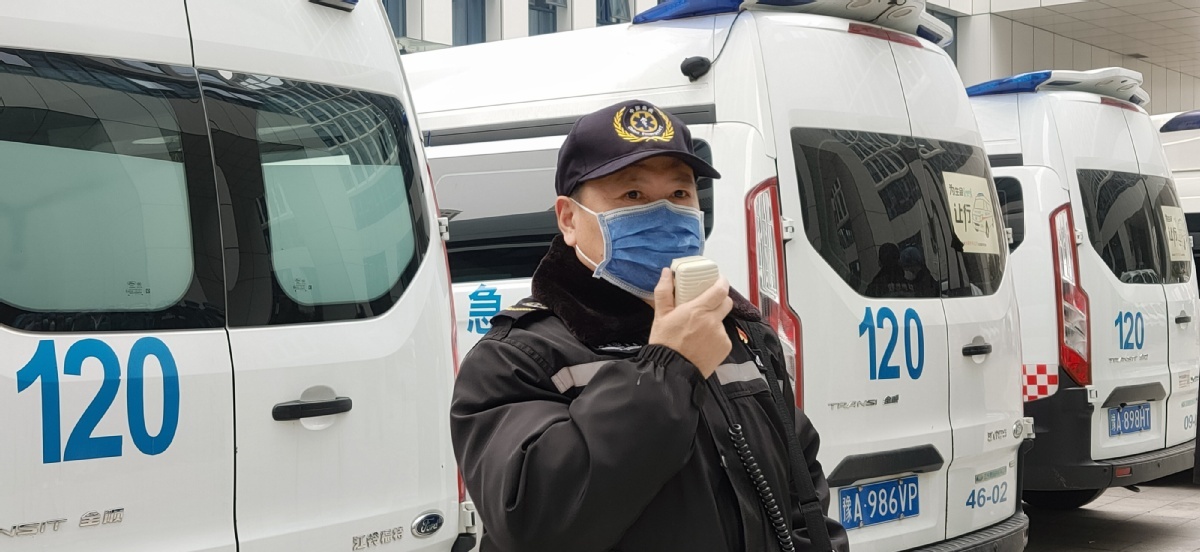
Qiao Wuying directs a transfer of COVID-19 patients in Wuhan, Hubei province, in February. He was part of the team sent from neighboring Henan province to help fight the epidemic in the hard-hit city. (Photos: China Daily)
During his 45-day stay in Wuhan early this year, Qiao Wuying, the head of a medical assistance team from Henan province, set foot in many of its streets and alleys but rarely got a chance to appreciate the city's skyline.
On March 19, the night before the 81-member team left Wuhan, Hubei's provincial capital and the Chinese city hit hardest by the COVID-19 pandemic, Qiao gathered his colleagues in front of the hotel they stayed in. With the outbreak waning, they could finally take a break.
"My team members wore goggles and face masks all the time and had missed the beauty of Wuhan," he said."I asked if two buses could be arranged to drive them around so they could take in the night view of the city."
As the director of the emergency medical rescue center in Zhengzhou, Henan's provincial capital, Qiao, 52, is used to racing against time to provide first aid and transfer patients to hospital.
However, arriving in Wuhan, an unfamiliar city 500 kilometers away, on Feb 5 posed fresh challenges.
"The first obstacle was how to ensure smooth communication," he said.
The team Qiao led brought one command car and 20 ambulances with them, but their communication systems were not compatible with the ones used by the first aid network in Wuhan.
"To solve the issue, we resorted to both very basic methods, such as exchanging information through WeChat messaging groups and walkie-talkies, and using highly advanced 5G," he said.
Qiao also urged the ambulance drivers to devote all the time they could to learning the roads of Wuhan with the help of navigation tools.
"We aimed to locate the patients in need and transport them to hospitals as quickly as possible," he said.

Qiao Wuying directs a transfer of COVID-19 patients in Wuhan, Hubei province, in February. He was part of the team sent from neighboring Henan province to help fight the epidemic in the hard-hit city.
Qiao had encountered similar difficulties during other medical assistance missions in his two decades of working in first aid.
"Nine of the 81 team members, including me, had also participated in rescue work for the Wenchuan earthquake in 2008," he said. "But in Wuhan, the danger was usually invisible. Every detail had to be meticulously thought out, and no slack was allowed."
Qiao said in Wuhan, they were "racing against the clock" and "walking on a tightrope" at the same time.
"Often, we had to come into very close contact with a patient who might be infected with the virus, holding their hands or carrying them on our shoulders," he said.
Even though the entire team had undergone training on preventing infections, Qiao remained deeply vigilant about safety and insisted on personally checking whether responders who were being called out for a task were wearing their protective equipment properly.
"We were dealing with uncertainties on a daily basis," he said."Unlike nurses and doctors who were mostly stationed at hospitals, we were shuttling between quarantine facilities in communities, elderly homes, mental health clinics and regular hospitals. We might run into an 80-year-old patient and then come across one who needed to be hooked up to a respirator immediately.
"The circumstances in Wuhan were unprecedented. Maintaining an ironclad policy of ensuring medical safety was meant to protect the patients as well as fellow medical workers."
In an emergency response mission on Feb 10, the local command center called for the immediate transfer of over 100 patients to Huoshenshan Hospital, one of the two makeshift hospitals built to receive COVID-19 patients, at about 6 pm.
"Within a few minutes, all personnel answered the call and got ready in head-to-toe protective clothing. Some had put on diapers," Qiao said.
"The mission was completed at about 3 am the next morning. Their clothing was completely soaked in sweat and their goggles fogged up. My heart ached for them, but at the same time, I was so proud of my team and my soldiers."
Team members transferred over 2,500 people to designated facilities during their 45 days in Wuhan, Qiao said, helping to ease the pressure on local first aid workers at the height of the outbreak.


